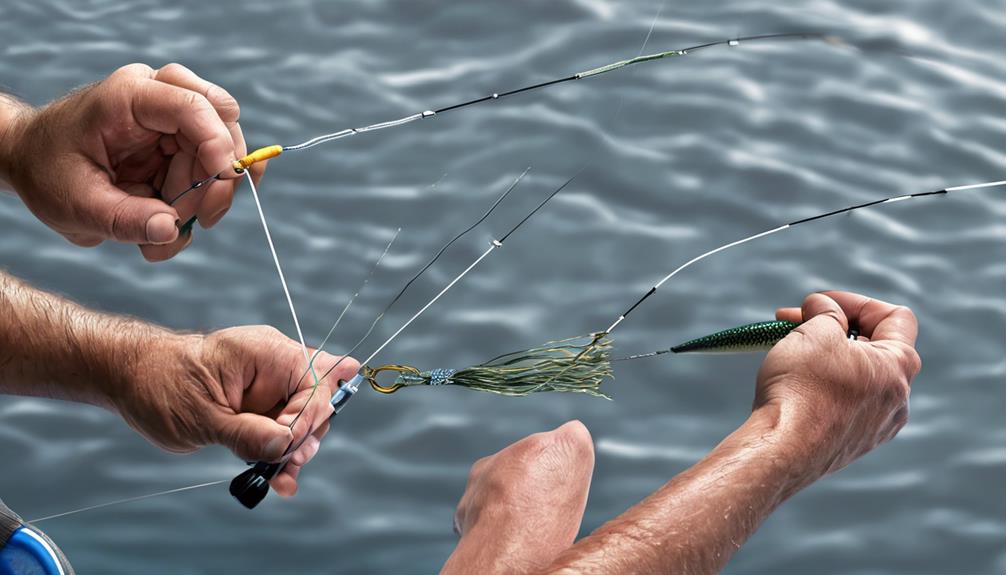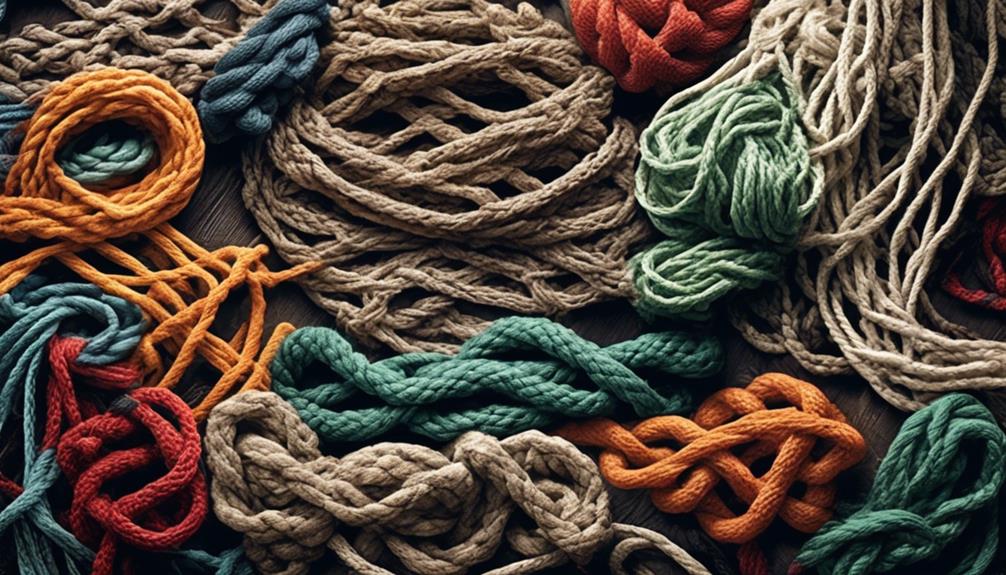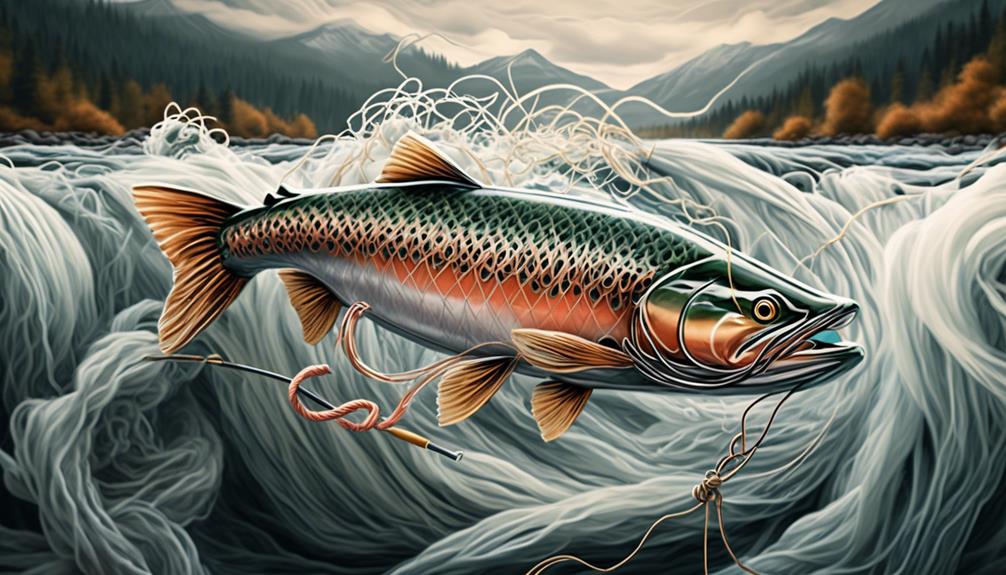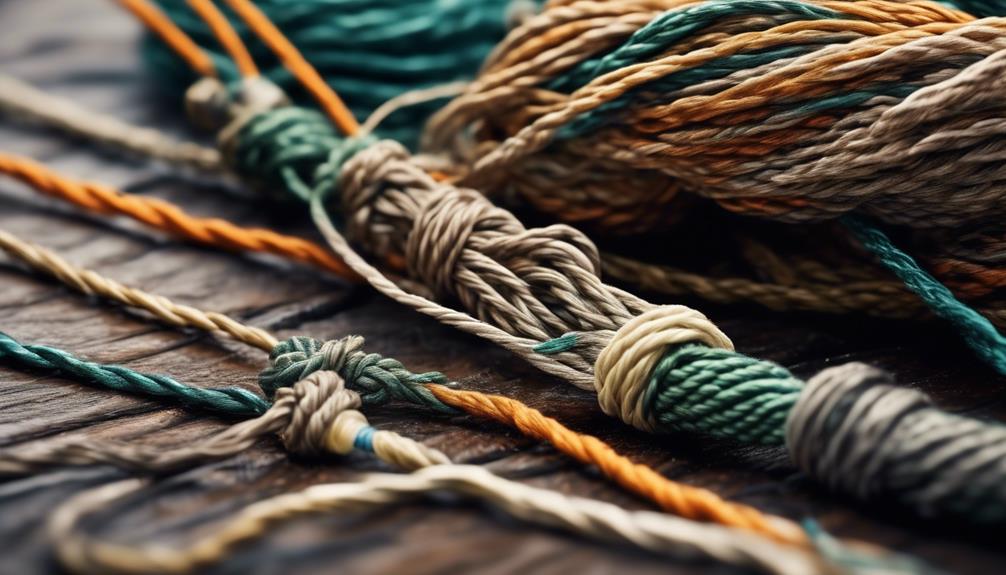So, you've decided to tackle the world of saltwater fishing, and you know that the key to success lies in the strength and reliability of your knots.
But with so many techniques out there, how do you know which ones work best for saltwater fishing?
Well, fear not, because in this discussion, we'll delve into the intricacies of knot tying, uncovering the most effective techniques and tips to ensure that your knots hold strong against the mightiest of oceanic adversaries.
So, grab your line and let's get started on unraveling the secrets of saltwater fishing knots.
Importance of Proper Knot Tying
Proper knot tying is essential for ensuring the safety and success of your saltwater fishing endeavors. When it comes to saltwater fishing, the significance of knot security and durability can't be overstated. The last thing you want is to lose a prized catch due to a poorly tied knot. Whether you're targeting big game fish or smaller species, using the right knots with proper security and durability is crucial.
Knot security is vital because it directly impacts your ability to land a fish. Imagine hooking a trophy fish only to have the knot slip or break under pressure. It's a heart-wrenching scenario that can be easily avoided by mastering reliable knot-tying techniques. A secure knot ensures that your line stays connected to the hook or lure, providing the strength needed to reel in your catch.
Equally important is knot durability. Saltwater fishing presents unique challenges due to the corrosive nature of saltwater. This environment can weaken knots over time, making durability a key consideration. A durable knot maintains its strength and integrity despite exposure to saltwater, ensuring that it can withstand the rigors of battling powerful fish in challenging conditions.
Understanding Different Types of Knots
When it comes to saltwater fishing, mastering different types of knots is essential for ensuring the security and durability needed to land your prized catch. Understanding the various types of knots and their specific applications can significantly improve your fishing experience. Here's what you need to know:
- Knot strength: Different knots have varying levels of strength. Some knots are designed to maintain close to 100% of the line's original strength, while others may weaken the line significantly. Understanding the strength of each knot is crucial for securing your catch without the fear of the line snapping.
- Knot selection: The type of fishing line and the fishing technique you plan to use will dictate which knot to select. For instance, the Palomar knot is excellent for braided lines, while the improved clinch knot is well-suited for monofilament lines. Knowing which knot to use in different situations can make a significant difference in your fishing success.
- Knot reliability: Each knot has its own level of reliability. Some knots are easier to tie but may be less reliable, while others may take more practice to master but offer superior reliability. Understanding the reliability of each knot ensures that your line stays secure when reeling in a tough fighter.
- Knot versatility: Certain knots are versatile and can be used in various fishing scenarios, while others are more specialized. Knowing the versatility of different knots can save time and effort when out on the water.
Understanding these aspects of different knots will allow you to select the most suitable knot for any saltwater fishing situation, ultimately increasing your chances of a successful and enjoyable fishing trip.
Choosing the Right Knot for the Job
To ensure secure and reliable knots for your saltwater fishing endeavors, it's crucial to understand how to choose the right knot for each specific fishing situation. When it comes to knot selection, one of the most important factors to consider is knot strength. Different knots have different levels of strength, and this can make a significant difference in your fishing success.
For instance, the Palomar knot is known for its exceptional strength and is a great choice for securing hooks to the line. On the other hand, the improved clinch knot is better suited for lighter lines and offers reliable strength for various applications.
Another key aspect of knot selection is understanding the specific requirements of the fishing situation. If you're targeting large, powerful fish, you'll need a knot that can withstand the force of the fight. In such cases, the double uni knot or the Bimini twist may be more suitable due to their superior strength. Conversely, when finesse and stealth are required, such as when fishing for wary, easily spooked species, a smaller, more discreet knot like the non-slip loop knot can be advantageous.
Ultimately, the right knot for the job depends on the specific conditions you're facing. By understanding knot strength and the unique demands of each fishing scenario, you can make informed decisions when selecting the most appropriate knot for your saltwater fishing adventures.
Step-by-Step Tying of Popular Knots
You can start by learning the step-by-step process for tying popular knots used in saltwater fishing. Mastering these knots is essential for ensuring a secure connection between your line and tackle, ultimately increasing your chances of landing a big catch. Follow these step-by-step instructions to confidently tie popular saltwater fishing knots:
- Improved Clinch Knot:
- Thread the line through the hook eye and double back to make 5-6 wraps around the standing line.
- Pass the tag end through the first loop and then through the big loop.
- Moisten the knot and pull the tag end to tighten. Trim the excess.
- Palomar Knot:
- Double about 6 inches of line and pass it through the eye of the hook.
- Tie an overhand knot with the doubled line, forming a loop.
- Pass the hook through the loop and pull the tag end to tighten. Trim the excess.
- Uni Knot:
- Run the line through the hook eye and double back, forming a loop.
- Make 5-6 wraps around the doubled line and through the loop.
- Moisten the knot and pull the tag end to tighten. Trim the excess.
- Blood Knot:
- Overlap the ends of the two lines and wrap one around the other 5-7 times.
- Thread the end through the center and then the opposite end through in the opposite direction.
- Moisten and pull the tag ends to tighten, trim the excess.
These knot tying techniques are essential for every angler. Practice these steps and master these popular knots with this saltwater fishing knots tutorial.
Tips for Ensuring Knot Strength
For increased knot strength, it's crucial to ensure that the wraps are tight and snug against the standing line, preventing slippage during the fishing process. One essential tip for ensuring knot strength is to use knot lubrication. Applying a small amount of saliva or water to the knot before tightening it can reduce friction and heat, allowing the knot to cinch down smoothly without weakening the line. This simple step can significantly improve the overall strength and durability of the knot.
Additionally, focusing on knot security is paramount. After tying the knot, always check that it's tight and secure. Gently tug on the tag end and standing line to ensure that the knot holds firm and doesn't slip. This extra step can prevent potential failures during the crucial moments of a catch.
When tightening the knot, pay attention to knot tension and elasticity. Applying steady and even pressure while cinching the knot helps to maintain its strength. Avoid pulling on the line too hard, as this can cause the line to stretch and the knot to lose its integrity. Balancing tension and elasticity ensures that the knot retains its strength without compromising the line's durability.
Utilizing Knot Tying Tools and Aids
Using specialized tools and aids can streamline the process of tying fishing knots, enhancing your efficiency and precision. When it comes to saltwater fishing, utilizing knot tying gadgets and aids can make a significant difference in your overall fishing experience. Here are some helpful tools and aids that can assist you in tying strong and reliable knots:
- Knot Tying Tools: Invest in knot tying tools such as knot-tying pliers or tools specifically designed to help you tie knots more easily. These tools can provide leverage and make it easier to handle small and intricate knots, especially in challenging weather conditions.
- Line Clippers: Keep a pair of quality line clippers handy to neatly trim excess line after tying knots. This ensures that your knots are secure and free from any unnecessary fraying, which can weaken the knot over time.
- Knot Tying Aids and Accessories: Consider using knot-tying aids like knot-tying cards or guides that provide step-by-step instructions for tying various fishing knots. These aids can be especially useful for beginners or when trying out new knot-tying techniques.
- Light and Magnification: Utilize a headlamp or a small magnifying glass to improve visibility when tying intricate knots, especially in low-light conditions or when dealing with fine lines. This can help you ensure that your knots are tied correctly and securely.
Common Mistakes to Avoid in Knot Tying

Avoid rushing the process of tying knots, as haste can lead to common mistakes that compromise the strength and reliability of your knots. One of the most common misconceptions in knot tying is believing that all knots are created equal. In reality, different knots have different strengths and are suitable for different purposes. Another mistake to avoid is using improper knot strength testing techniques. It's essential to test the strength of your knots by applying steady pressure rather than jerking the line, as jerking can lead to inaccurate readings and potential damage to the knot.
Additionally, failing to wet the knot before tightening it's a common mistake that can weaken the knot and reduce its overall strength. The friction generated during the tightening process can cause excessive heat, which in turn weakens the line. Always remember to wet the knot with either saliva or water before pulling it tight. Furthermore, inadequate attention to detail when tying the knot can result in overlapping or crossed lines, ultimately leading to reduced knot strength and potential failure when under pressure.
Lastly, neglecting to trim the tag end of the line after tying the knot can lead to tangles and snags, compromising the overall effectiveness of the knot. Taking the time to carefully trim the tag end will ensure a smoother and more efficient fishing experience. Avoiding these common mistakes will help you tie stronger, more reliable knots for your saltwater fishing adventures.
Practicing and Mastering Knot Tying Skills
To improve your saltwater fishing knot tying skills, practice and mastery are crucial. Here are some tips to help you practice and master your knot tying techniques for practical applications:
- Consistent Practice: Dedicate regular time to practicing knot tying. Find a variety of ropes and lines to work with, as different materials may require different techniques. The more you practice, the more familiar and adept you'll become with various knots.
- Use Visual Aids: Utilize online tutorials, books, or videos to learn different knot tying techniques. Visual aids can provide step-by-step instructions and demonstrations, making it easier for you to understand and replicate the knots accurately.
- Seek Feedback: Practice tying knots in front of an experienced angler or instructor who can provide constructive feedback. Having someone point out any mistakes or offer tips for improvement can greatly enhance your knot tying skills.
- Real-world Application: Take every opportunity to apply your knot tying skills in real fishing scenarios. The more you use the knots in practical applications, the more comfortable and confident you'll become in tying them under various conditions.
Frequently Asked Questions
What Are the Best Knots to Use for Specific Types of Saltwater Fish, Such as Tuna or Marlin?
When fishing for tuna and marlin in calm saltwater conditions, the best knots to use are the Bimini twist for connecting a double line to the leader, and the improved clinch knot or Palomar knot for attaching the hook or lure.
These knots provide the strength and reliability needed to handle the powerful runs and acrobatic jumps of these big game fish.
Mastering these knots will greatly increase your chances of landing a trophy catch.
Are There Any Knots That Are Particularly Effective for Saltwater Fishing in Rough or Choppy Conditions?
In rough or choppy conditions, knot strength is key for successful saltwater fishing. When facing windy conditions, fishing techniques that prioritize secure knots can make all the difference.
Ensuring your knots are tight and reliable will help prevent slippage or breakage, increasing your chances of landing that big catch. Consider using strong and dependable knots like the Palomar knot or the improved clinch knot to tackle the challenges of saltwater fishing in rough waters.
What Are Some Tips for Tying Knots With Heavy-Duty Saltwater Fishing Lines?
When tying knots with heavy-duty saltwater fishing lines, you'll want to keep a few tips in mind.
- Start by selecting the right knot for the job. Techniques like knot testing and strength assessment can help you determine the best option.
- Ensure the line is properly lubricated and cinch the knot tightly.
- Use reliable resources to learn and practice different knot tying techniques, and always test the strength of your knots before heading out on the water.
Are There Any Specialized Techniques for Tying Knots When Using Live Bait or Lures in Saltwater Fishing?
When using live bait or lures in saltwater fishing, specialized techniques for tying knots can be essential. You can benefit from using knot tying tools and methods specifically designed for securing live bait or lures to your fishing line.
These techniques are important for ensuring that your bait or lures are effectively attached and won't come loose while fishing in saltwater.
How Can I Tell if My Knot Is Securely Tied and Will Hold up Against the Strength of a Large Saltwater Fish?
To ensure your knot holds up against a large saltwater fish, try this:
After tying the knot, give it a good tug to test its strength. If it feels secure and doesn't slip or loosen, you're good to go.
Various techniques, like the improved clinch knot or the Palomar knot, work well for saltwater fishing.
Experiment with different knots and testing methods to find what works best for you.
Conclusion
So, now that you've learned about the importance of proper knot tying, different types of knots, and how to choose the right knot for the job, it's time to put your knowledge into practice.
Remember to follow the step-by-step instructions for tying popular knots, ensure knot strength, and avoid common mistakes.
With practice and mastery, you'll be well-equipped for successful saltwater fishing adventures.
Happy fishing!



